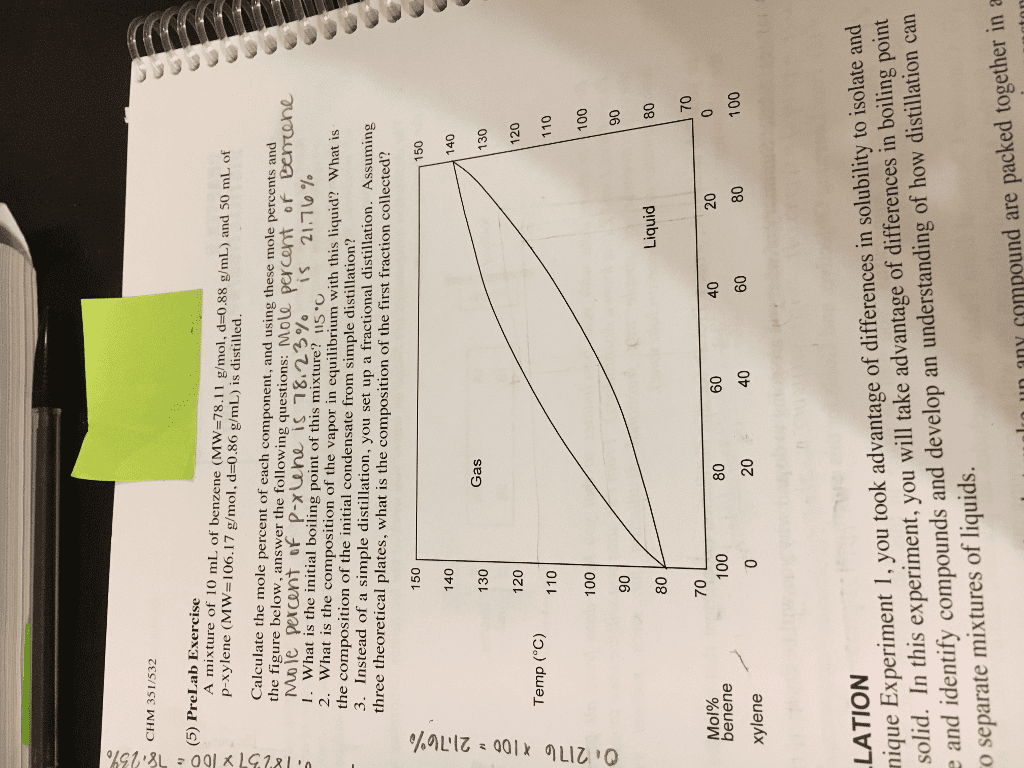CHE 211 Study Guide - Midterm Guide: Ideal Solution, Lead, Mole Fraction

Organic Chemistry 2 – Chemical Purification & Separation
Simple Distillation
Distillation is a general technique used into the organic labs for the removal of a solvent to
purify a liquid to separate the components of a liquid mixture
Distillation is used in the organic lab as a way to:
- Remove a solvent
- Purify a liquid
- Separate the components of a liquid mixture
Four types of Distillation:
- Simple
- Fractional
- Vacuum
- Steam
Distillation
o Pure liquids boils when its vapor pressure equals the external pressure: approx. 1 atm, rr
760 torr; the vapor above the liquid contains the same molecules at the liquid and
thereby has the same composition
o If the liquid is water, the vapor above the liquid is still water (the only difference is that
it is in the gas phase instead of the liquid phase)
o Composition of the vapor is the same as the composition of the liquid
o A mixture of 2 or more liquids with different vapor pressures will boil when total vapor
pressure over the mixture EQUALS the external pressure
o However, the composition of the vapors will NOT have the same composition as the
liquid
o This is because the vapor above the liquid will be enriched of which that has the LOWER
boiling point --> remember that liquids that have low boiling points will have a higher
volatility, high vapor pressure than a liquid with higher boiling point, less volatile and
lower vapor pressure
o If the vapors above the liquid were allowed to condense, and then are collected, they
would have the same composition as the vapors --> this means that it would be more
richer and more volatile component of the mixture (this is the basis of distillation)
The process of vaporizing a liquid mixture in one vessel and condensing the vapors into another
vessel is called distillation
- A liquid is vaporized by boiling it and then condensed back to a liquid called a distillate
or a condensate (collected in a separate flask called the receiving flask)
find more resources at oneclass.com
find more resources at oneclass.com

- The liquid distilled is called the distilland
- The apparatus for a simple distillation can be seen below
Once the liquid starts to boil, its vapors move out of the distillation flask, up through the
distillation head, and finally condenses on the cold surface of the water cold condenser
The resulting liquid called the distillate is collected in the receiving flask; if the mixtures
of the liquid have vapor pressures that are sufficiently different, the distillate will be
enriched in the more VOLATILE component --> the less volatile component will remain
in the distillation flask
Distillation Theory
▪ The purity of the distillate will increase with the increase in the number of
vaporization/condensation cycles --> this is the number of times a liquid is vaporized
and condensed on its way to the receiving flask
▪ The greater number of cycles means the more pure the distilland will be
▪ Simple distillation has one vaporization-condensation cycle; simple distillation works
best only for the purification of a liquid that contains either non-volatile impurities or
small amounts of higher or lower boiling impurities
▪ Fractional distillation has several vaporization-condensation cycles; fractional
distillation goes through many vaporization/condensation cycles --> it is usually
find more resources at oneclass.com
find more resources at oneclass.com
Document Summary
Organic chemistry 2 chemical purification & separation. Distillation is a general technique used into the organic labs for the removal of a solvent to purify a liquid to separate the components of a liquid mixture. Distillation is used in the organic lab as a way to: Separate the components of a liquid mixture. Distillation: pure liquids boils when its vapor pressure equals the external pressure: approx. 760 torr; the vapor above the liquid contains the same molecules at the liquid and thereby has the same composition. The process of vaporizing a liquid mixture in one vessel and condensing the vapors into another vessel is called distillation. A liquid is vaporized by boiling it and then condensed back to a liquid called a distillate or a condensate (collected in a separate flask called the receiving flask) The liquid distilled is called the distilland. The apparatus for a simple distillation can be seen below.




